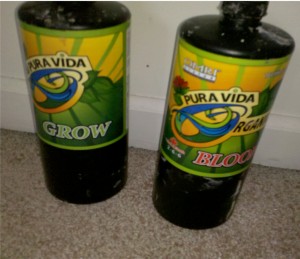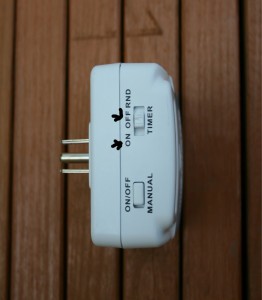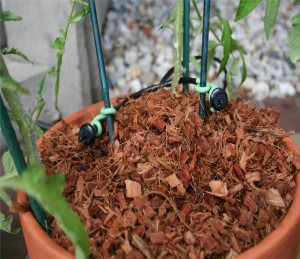
Pura Vida is a pretty well known brand of hydroponic nutrients, and has been tried by a lot of different gardeners. Pura Vida hydroponic nutrients are great for indoor gardening because they come in liquid format. You measure out the desired amount of nutrients, and pour them into a gallon of water. After mixing the nutrient solution, it is ready for use.
You apply Pura Vida nutrient solutions with normal irrigation. The best time for feeding is usually in the morning, when the plant is just starting its metabolic processes for the day.
Note: The Pura Vida Organic Solution was OMRI Certified Organic. The Pura Vida Grow was not organic. The plants did not seem to notice the transition.
The first things you need to know about the Pura Vida combo is there are micro nutrients built in. It is a two part solution, but only one part per phase. One part per phase is talking about the growing phase of the plant, Grow or Bloom.
You only need to use the grow for the first part of their life. You only need to use Bloom for the second part of their life.
If you are new to hydroponics, I recommend starting with that type of simplicity. You are making up for the simplicity with the quality of nutrients.
Advanced Gardener’s Box: There are instructions for an aggressive two part formula on the back labels of these bottles. The PPM of the nutrient solution is MUCH higher than the one part formulas. Only experienced gardeners should attempt the aggressive formula once you know how to grow your particular variety of plant. It is very easy to salt lock your plants with this aggressive formula. You need to do frequent water changes to ensure balanced PH.
The Negatives:
I tested the nutrients in a large variety of hydroponics systems including three different drip systems. On the drip systems that used drip emitters, about 1 in 10 drip emitters would clog from the organic material. One way to defeat those clogs is to mesh out the chunks of fertilizer before you pour it in your reservoir. There are also pre-filter systems that can catch some of those pieces.
In open-ended 1/4 inch tube drip systems, with no drip emitter, the nutrients worked beautifully. The key to success with the open-ended tube system is to lower the ppm of your nutrient solution while buffing the number of regular feeding times as the plant grows and expands it’s root system.
The open 1/4 inch tube allows the root systems to get optimal amounts of aerated water. Use an aeration stone in your reservoir so the nutrient solution stays oxygenated and moving. The open ended 1/4 inch tube allows the water to connect with more air molecules before landing in the plant container. This system works for hydroponics, soil-less, and even soil growing methods. Talk about versatility.
Overall
Consider trying these nutrients if you have never used them. The bottles cost a little more than the lower end hydroponic nutrients, but thats for a reason. Do not under estimate the strength of these nutrients. Make sure to lower the ppm of your nutrient solution so you do not get salt locked plants. These nutrients can go up to three weeks with no water change in a 15gallon + reservoir. However, you should monitor your PPM for optimal conditions. Water changes every 12-14 days with a standard plain water rinse out is typical.
Look for the OMRI Certified bottles at your local hydro shop or you can order them online.
Looking for More Information?
Best Price On: Pura Vida Oraganic Nutrients.
Happy Growing!























